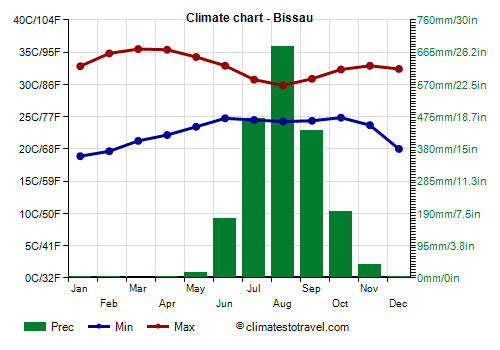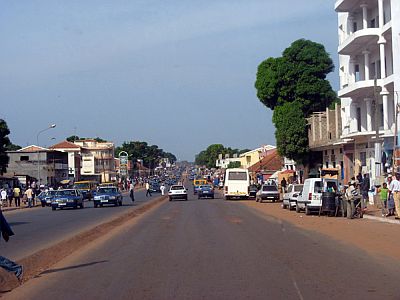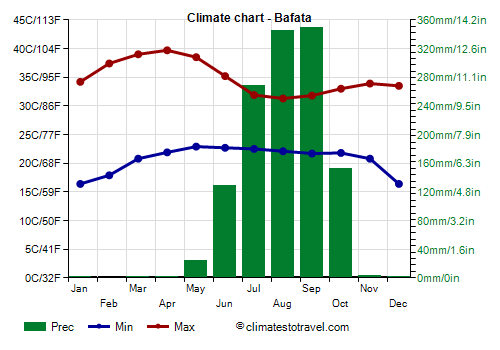Select units of measurement for the temperature and rainfall tables (metric or imperial).
Average weather, temperature, rainfall, sunshine
In Guinea-Bissau, the climate is
tropical, hot all year round, with a dry season from November to May, and a rainy season from June to October due to the African monsoon.
The hottest period runs from February to May, before the rains, while the rainy season, though less hot, it's muggy. The heat is intense especially in the interior, while along the coast, where Bissau is located, it is relieved by the breeze.
The monsoon
rains are definitely heavy, especially from July to September, when they can cause widespread flooding. In addition, the sky in this period is often cloudy. August is the rainiest month, and if possible, it should be avoided. The rainfall is more abundant in the central-southern part of the coast, where it exceeds 2,000 millimeters (79 inches) per year, and less abundant in the north-east, where it drops below 1,500 mm (60 in) per year.
During
winter, there's good weather, and the air is dry because of the prevailing wind, the
Harmattan, which blows from the desert, and can bring dust, making the sky whitish. Normally, the daytime temperature is about 30 °C (86 °F), but it can sometimes reach 40 °C (104 °F). However, this is the best time of the year.
Starting from February, both temperature and humidity gradually increase, reaching a peak between March and May, when the temperature can easily surpass 40 °C (104 °F).
Starting in June, in the
rainy season, the temperature decreases to about 29/30 °C (84/86 °F). The weather gets muggy, but at least the heat on the coast is tempered by the breeze.
The climate in detail
The coast
Bissau

In
Bissau, the capital, located in the central part of the coast, the average temperature fluctuates between 26 °C (79 °F) in January and almost 29 °C (84 °F) from April to June.
In Bissau, precipitation amounts to 2,000 millimeters (79 inches) per year.
In Bissau, the sun often shines from November to May, while the sky is often cloudy in the rainy season, especially in the wettest period, from July to September.
The
sea is always warm enough for swimming, although it is warmer from June to November, when the water temperature is about 28 °C (82 °F), while in March and April, it drops to 24 °C (75 °F).

Inland areas
As mentioned, in inland areas, the climate is very hot in the period before the rains, from March to May. In the monsoon period, the rains are abundant, but less than on the coast.
Bafatá

In Bafatá, located in the north-east, the heat is intense in the months preceding the monsoon, and in April, the maximum temperatures reach 39.7 °C (103.5 °F) on average.
In Bafatá, 1,270 mm (50 in) of rain fall per year.
Tropical cyclones
In the ocean to the west of Senegal, there is an area in which
hurricanes, the tropical cyclones of the Atlantic, start to form; after they are formed, they move towards the west or the northwest and head to the Caribbean. In general, the country is not affected by hurricanes because they develop at a considerable distance, however, a hurricane can occasionally be formed a short distance from the coast and affect Guinea-Bissau as well, with rainfall as well as storm surges that can damage the coast, as happened at the beginning of September 2015 with Hurricane Fred.
Hurricanes are generally formed in this area in August and September.
When to go
The best time to visit Guinea-Bissau is
winter, in particular, the months of December and January, which are the least hot among those in which it does not rain. It may be useful to bring a scarf for the dust brought by the wind.
For a
beach holiday, the dry season, from November to May, is preferable.
What to pack
In
winter: in Bissau and on the coast, bring light clothes for the day, a sweatshirt for the evening, and a scarf for the wind-borne sand and dust. In inland areas, you can add a light jacket for the evening.
In
summer: bring light clothing of natural fibers, a light sweatshirt and a light raincoat for the rain.
Climate data - Guinea Bissau
| Bafata |
|---|
|
| Jan | Feb | Mar | Apr | May | Jun | Jul | Aug | Sep | Oct | Nov | Dec |
|---|
| Min temp. | 16 | 18 | 21 | 22 | 23 | 23 | 22 | 22 | 22 | 22 | 21 | 16 |
|---|
| Max temp. | 34 | 37 | 39 | 40 | 38 | 35 | 32 | 31 | 32 | 33 | 34 | 34 |
|---|
| Precip. | 0 | 0 | 0 | 0 | 25 | 130 | 270 | 345 | 350 | 150 | 5 | 0 |
|---|
| Prec. days | 0 | 0 | 0 | 0 | 3 | 9 | 17 | 23 | 27 | 10 | 1 | 0 |
|---|
|
|
|
|
| Bissau |
|---|
|
| Jan | Feb | Mar | Apr | May | Jun | Jul | Aug | Sep | Oct | Nov | Dec |
|---|
| Min temp. | 19 | 20 | 21 | 22 | 23 | 25 | 24 | 24 | 24 | 25 | 24 | 20 |
|---|
| Max temp. | 33 | 35 | 35 | 35 | 34 | 33 | 31 | 30 | 31 | 32 | 33 | 32 |
|---|
| Precip. | 0 | 0 | 0 | 0 | 15 | 175 | 470 | 680 | 435 | 195 | 40 | 0 |
|---|
| Prec. days | 0 | 0 | 0 | 0 | 2 | 11 | 22 | 24 | 21 | 13 | 2 | 0 |
|---|
| Humidity | 36% | 38% | 49% | 54% | 61% | 70% | 81% | 85% | 81% | 77% | 64% | 48% |
|---|
| Day length | 12 | 12 | 12 | 12 | 13 | 13 | 13 | 12 | 12 | 12 | 12 | 11 |
|---|
| Sun hours | 8 | 8 | 9 | 9 | 9 | 6 | 4 | 3 | 5 | 7 | 8 | 8 |
|---|
| Sea temp | 25 | 24 | 24 | 24 | 26 | 28 | 28 | 28 | 28 | 29 | 29 | 27 |
|---|
| Bolama |
|---|
|
| Jan | Feb | Mar | Apr | May | Jun | Jul | Aug | Sep | Oct | Nov | Dec |
|---|
| Min temp. | 19 | 19 | 21 | 21 | 22 | 22 | 22 | 22 | 22 | 22 | 22 | 19 |
|---|
| Max temp. | 32 | 34 | 34 | 33 | 33 | 32 | 30 | 30 | 30 | 32 | 32 | 32 |
|---|
| Precip. | 0 | 0 | 0 | 0 | 30 | 195 | 535 | 620 | 425 | 200 | 20 | 0 |
|---|
| Prec. days | 0 | 0 | 0 | 0 | 2 | 12 | 24 | 27 | 24 | 17 | 4 | 0 |
|---|
|
|
|
|
See also the
temperatures month by month